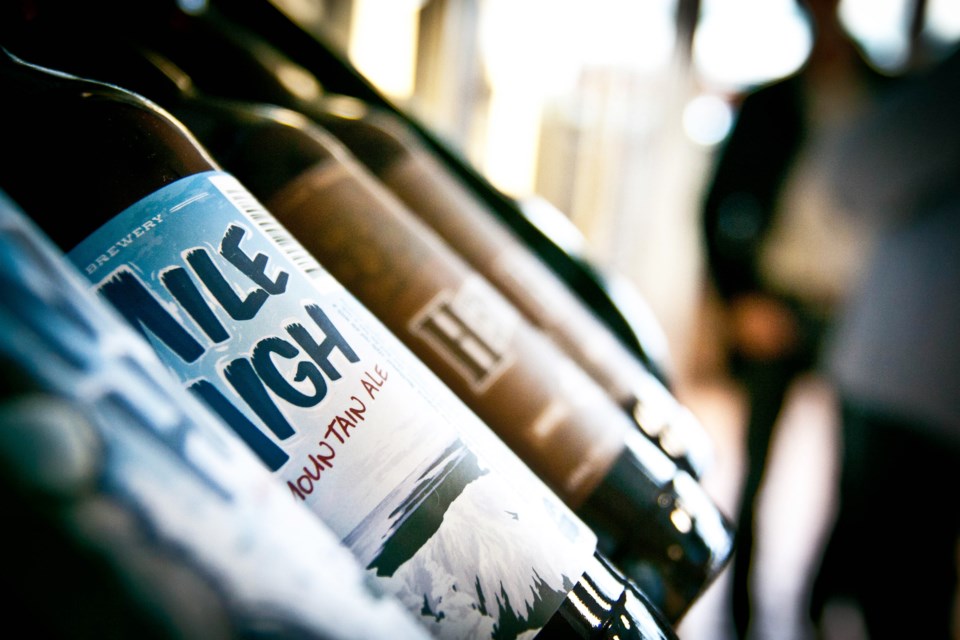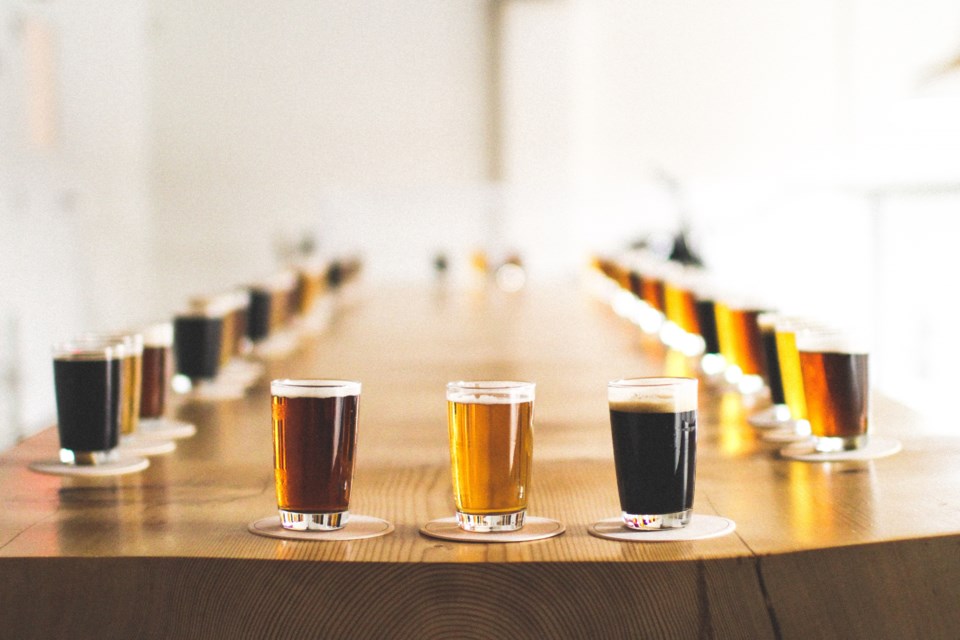A man in his 50s, or so it seems, walks down Main Street wearing a T-shirt sporting Vancouver Island Brewing’s Absolute Darkness label. He strolls past a sandwich board advertising Red Truck and into Colony Bar, past the two of us in the window, sipping pints of craft beer from a tap list dominated by microbrews.
It’s an idyllic moment for a brainy sort of beer nerd – Utopian, even, and something few of us would have seen coming five years ago.
My drinking partner, Don Gordon, vice chairman of the BC Craft Beer Guild (BCCBC), says, “In this part of the city, you’re going to see 25 to 30 per cent of all beer consumed being craft. Here,” – as in this particular neighbourhood of Vancouver – “[craft beer] has gone mainstream.”
This is good to know. We’re sitting at the brand new Colony location on Main Street to discuss the very idea: Has craft beer gone mainstream? He points out that in certain areas of Vancouver, Victoria and New Westminster, craft breweries are supplanting neighbourhood pubs, or – as in the case of Colony – pubs are serving up predominately craft.
“Twenty years ago, you could go to the pub that was basically owned by Labatt or Molson, and that was all you [could] drink,” he says, referring to what’s known as tied houses – public houses that are required to buy at least some of their beer from a particular brewery or pub company. “Today, you have breweries that are pillars of the community. You’re actually going to a tied house, but it’s a tied house by choice.” Generally run by members of the community, he adds.
Meanwhile, the refrigerators in private liquor stores stock more 650 ml bottles of local beers with the passing of every week, and there seems to be an unwritten rule that any new bar or restaurant within Vancouver city limits must feature at least a few local microbreweries. Parallel 49 is on tap at Rogers Arena and Whistler Brewing Co. recently landed a contract as Nat Baily Stadium’s official beer sponsor.
A walk around town proves the influence extends well beyond bars and liquor stores. Whole Foods on Cambie Street has started hosting weekly craft cask tastings. Williams Sonoma on Granville Street recently partnered with California’s Anchor Steam for a craft beer/cooking event. Developers in trendy areas have adopted craft-y aesthetics and lingo to sell apartments, and a colleague recently went to an open house that was enticing home buyers with free samples of Off The Rail.
But at the same time, craft beer makes up only 20 per cent of the beer market, which means four out of five BC beer drinkers are buying beer produced by Molson, Labatt, Budweiser and the like.
“The overwhelming majority of beer is what everyone calls macro. That is a fact. You can’t dispute it,” says Tim Barnes, vice president of marketing and sales at Central City Brewers + Distillers. This is proof enough that craft beer is nowhere close to mainstream.
“[Craft is] growing at a faster rate than Seattle and Portland, so we’re catching up, but until we reach that tipping point of 40 or 50 per cent of beer, is it mainstream? I don’t know.”
What is mainstream, anyway?
Mainstream is defined as a commonly accepted idea or product that’s perceived by the majority as mainstream through its dissemination by mass media (thanks Wikipedia).
If we look at it purely from sales figures, then the craft beer culture is, at most, a subculture. But then again, mainstream doesn’t necessarily mean that the majority is buying the product, just that they’re aware of it.
There are no statistics to indicate how many people are aware of craft beer, but if its coverage in mainstream media is any indication, it’s likely a high percentage. Stephen Quinn discusses the topic regularly on his CBC radio show, “On the Coast,” which features Rebecca Whyman as a regular beer columnist. The Province runs regular craft beer reviews and long-form features. Vancouver Magazine recently published the winners of its 2015 Craft Beer Awards. The Georgia Straight ran a craft beer cover story two weeks ago, and the Westender is running one this week.

And then there’s Vancouver Craft Beer Week (VCBW), which has grown from 150 people in its first year at Heritage Hall in 2009, to the 10,000 people expected over two days this weekend at the PNE festival grounds. It’s a cultural force and has significant support from the City of Vancouver. As an organization, VCBW has evolved into the most flamboyant, celebratory proponent of craft culture and industry in the province.
But Chris Bjerrisgaard, VCBW’s co-founder and marketing director, says the festival’s evolution is merely an indication of how much bigger craft beer can – and probably will – grow.
“It has a ways to go because we [the BC craft beer industry] have basically zero maturity,” Bjerrisgaard says. “We’ve only been doing this as a broader industry for about five years. There are breweries that have been around before that, but I think even they would say that 2010 was the tipping point.”
“All these breweries have opened up, which is fantastic,” he continues. “They’re going to inspire each other to make better beers. Right now, not everything that’s coming out is world-class product. People are still finding their footing, and that’s OK. Let’s give it some time to mature a little.”
He points to Oregon, which has had a beer festival for almost as long as BC has had an industry. VCBW comes nowhere close to the number of attendees as the annual Oregon Brewers Festival. And BC’s biggest craft breweries are producing nowhere close to what their American counterparts are.
“If it was truly mainstream,” Bjerrisgaard says, “the biggest craft brewery in the province would be selling more than 60,000 hectolitres a year. Look at something like Deschutes [in Oregon] and what they sell.”
In Portland, craft beer makes up over 50 per cent of the market. That number drops outside city limits, but Mike Foy, Deschutes’ zone manager for Oregon, Washington and Hawaii, says even rural pockets as far as Ontario, on the border of Oregon and Idaho, sell a lot of craft.
“Most people are aware of it, they know what it is,” Foy says. “It’s not an underground thing anymore, and it’s growing tremendously.”
Portland’s approach to beer has been hugely influential across the continent. Seattle and Denver have cultivated strong beer cultures based on Portland’s model, and more recently, Northern California, San Diego, the Virginias, Honolulu and Austin, Texas, are all seriously on the upswing. Craft beer closed 2014 with 11 per cent of the total American market share – a 17.6 per cent growth nationwide, according to Brewers Association. This doesn’t include growth in Vancouver, Toronto, Mexico City and other areas.
But is mainstream a good thing?
The rise of BC craft beer has meant the rise of beer nerd antagonism. The Internet is awash in highly opinionated (usually hypercritical) beer bloggers, but the most well-read – and, arguably, most thoughtful – of the bunch is Chuck Hallett, more commonly known as Barley Mowat. He’s positioned himself as the cantankerous old guard and, in blog form, his opinions read as a man skeptical of the industry’s newfound popularity (and very critical of what he claims is Parallel 49’s decline in quality).
But in person, it’s clear Hallett’s campaign is rooted in a wry sort of benevolence. He cares deeply about the beer and wants to see craft beer prevail.
“I always tell people that I’d like to live in a world where Annheuser-Busch is producing a barrel-aged Russian Imperial stout,” Hallet says.
“They say, ‘What would you do if that happens?’ Well, craft beer won. That’s craft beer. I don’t care who’s making it. It’s great beer. Annheuser-Busch is making it… and they’re tipping their hat to say craft beer is the way to go.”
So what’s it going to take to get to that point, then?
The first thing is time. The second is greater support from the provincial government to ensure that more beer is more easily available to more people.
That isn’t happening and, according to Gordon, the situation might get more complicated in the coming months.
“There’s so much going on right now [in regards to the liquor changes] and it’s not totally clear what’s going to happen in the next three months,” he says.
The factors are colliding, he explains, with craft beer on the rise, major liquor reform in the form of wholesale coming, and the introduction of grocery stores as a new sales channel all at once.
“What you have is people unfairly blaming the LDB on what’s happening in terms of private retailing and craft beer. I think it’s unfair because no one could see the perfect storm coming.”
He says more consultation with industry could have been done, but he doesn’t consider this an intentional cash grab – more of a growing pain as government transitions to a new way of doing things. The BCCBG has been working to ensure that the growing craft industry’s voice isn’t lost in the process.
“We’re talking with them, but we’re talking with them after the fact,” Gordon says. “Obviously we’re dealing with government special interests groups.”
He says that getting an official craft beer distinction, similar to VQA for BC wines, is paramount to ensuring the industry’s health. The problem is that VQA is an agricultural distinction (BC grapes = BC wine). Craft brewers use hops and malts imported from other countries, so a distinction is dependent on another set of criteria, which Gordon admits is certainly a challenge. “Craft beer,” after all, is nearly impossible to define.
But as Barnes over at Central City sees it, going “mainstream” doesn’t fit in to the craft beer equation. Like, at all.
“[The] craft beer definition isn’t mainstream. The whole reason people get in to craft beer is not to be mainstream. It’s to do something different,” he concludes.


